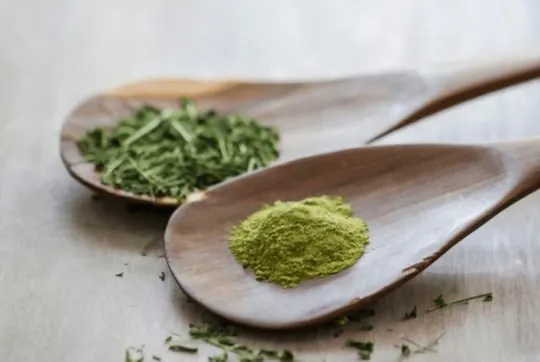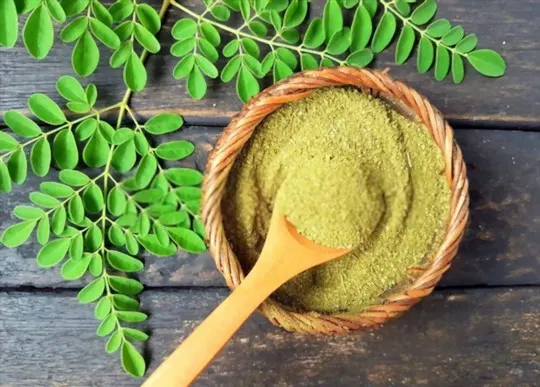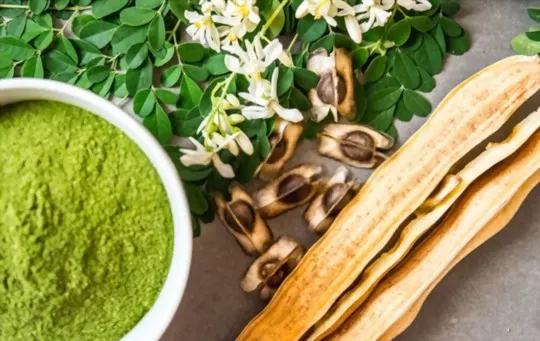Are you one of those people who hears about all the amazing benefits that moringa has to offer, but is wondering what it actually tastes like
Don’t worry, many other adventurous food lovers are equally perplexed.
Fortunately, in this blog post we will review not only what moringa tastes like – but how its flavor compares to other ingredients and how it can be cooked and incorporated into a variety of recipes.
So grab your favorite beverage and prepare your taste buds for an exploration around the fascinating flavors ofmoringa!
What is Moringa?

Moringa, also known as the drumstick tree, is a plant native to India that has gained popularity worldwide for its various health benefits.
It is often used in traditional medicine to treat various ailments due to its anti-inflammatory and antioxidant properties.
When it comes to its taste, Moringa has a mild flavor profile that can be described as similar to spinach or green tea.
Its leaves have a slightly bitter and earthy taste, while the pods and seeds have a more neutral taste.
Moringa powder, which is made by drying and grinding the leaves, has a slightly sweet and nutty flavor.
This makes it a great ingredient for smoothies or as a topping for salads and soups.
Overall, Moringa is a versatile and nutritious plant that can be used in a variety of culinary applications.
When adding Moringa powder to your food, start with a small amount and gradually increase the dosage to avoid any digestion-related issues.
What Does Moringa Taste Like?

Moringa leaves have a slightly bitter taste with a hint of sweetness, similar to spinach or arugula.
Both the leaves and pods can be eaten raw or cooked but have a different taste profile.
Moringa leaves have a delicate flavor and lose their bitterness when cooked.
The pods have a mild flavor and a slightly fibrous texture, similar to asparagus or green beans, and taste best when cooked.
Moringa leaves have also been described as having a nutty taste and can be used to make tea or added to smoothies or soups.
The taste of moringa powder varies depending on how it is processed, with some brands having a grassy or earthy taste.
If you are new to moringa, start by adding a small amount to your dishes and gradually increase the quantity as you become accustomed to the taste.
Factors that Affect the Taste of Moringa

Moringa has a unique taste that has been described as earthy, bitter, and slightly sweet.
However, several factors can affect the taste of Moringa, including the age of the plant, the location where it was grown, and the method of preparation.
- Age of the plant: Young Moringa plants tend to have a milder flavor and are less bitter than mature plants. If you find the flavor of mature Moringa leaves too strong, you can opt for younger leaves for a milder taste.
- Location: The soil type, climate, and altitude can all affect the flavor of Moringa. The plant tends to have a more pungent taste when grown in dry and arid regions.
- Method of preparation: Moringa can be consumed raw, cooked, or dried. The taste also varies depending on how it is prepared. For instance, Moringa tea has a more delicate flavor, whereas adding Moringa leaves to a smoothie can give that earthy and bitter taste.
Keep these factors in mind while using Moringa, and experiment with different ways of preparation to find the right flavor profile.
It’s important to note that the strong taste of Moringa may not be appealing to everyone’s palate.
You can try combining it with other ingredients or using it in small quantities to get accustomed to its taste.
1 – Age of the Leaves
When it comes to the taste of Moringa, the age of the leaves plays a crucial role.
Younger leaves tend to have a milder and more palatable taste, while older leaves tend to have a bitter and slightly unpleasant taste.
Depending on your taste preferences, you may prefer younger leaves for their mild flavor that adds a delicate nuttiness to your dishes or opt for the more mature leaves that have a stronger taste that can add depth to soups and stews.
The overall taste of Moringa is often described as earthy, similar to spinach or matcha, with a slightly bitter aftertaste.
However, the taste can vary depending on the age of the leaves, the way they are prepared, and the other ingredients they are paired with.
To mellow out any bitterness in Moringa leaves, try blanching them in boiling water for a few seconds before adding them to your dishes.
This can help reduce the bitterness and enhance the flavor.
2 – Soil Quality and Climate
Soil quality and climate play a significant role in determining the taste of Moringa leaves.
Moringa is a versatile green that has a unique and slightly bitter taste that is often compared to arugula, watercress, or radish.
The taste of Moringa can vary depending on the following factors:
- Soil nutrient levels: The flavor of Moringa is influenced by the soil’s nutrient levels, particularly the nitrogen content.
- Climate: Moringa grows best in tropical and subtropical climates. The leaves harvested from plants grown in warmer climates are generally sweeter and less bitter than those grown in cooler climates.
- Plant maturity: The taste of Moringa leaves can also vary depending on the maturity of the plant. Younger leaves tend to be more tender with a softer, milder taste while mature leaves have a tougher texture and a more pronounced, bitter taste.
To balance the slight bitterness in Moringa, try pairing it with fresh citrus or spritz it with a bit of lemon juice before serving.
3 – Preparation Method
Moringa has a mild, earthy flavor, often described as similar to spinach, combined with a slightly bitter aftertaste.
Here are a few ways to prepare Moringa to improve its taste:
- Use fresh Moringa leaves in a salad or a sandwich for a quick and healthy meal.
- Add Moringa powder to your favorite smoothies or protein shakes.
- Brew Moringa leaves as a tea by boiling water and steeping the leaves for 5-10 minutes. You can add honey or lemon to enhance the flavor.
- Cook Moringa pods or drumsticks as a vegetable side dish. They have a unique flavor that combines well with spicy or savory dishes.
With these different preparation methods, Moringa can be a delicious and healthy addition to your diet.
How to Incorporate Moringa into Your Diet?

Moringa is a superfood that can add an array of nutritional benefits to your diet, and incorporating it into your meals is easy, thanks to its versatility.
However, before adding moringa to your diet, you may wonder what it tastes like.
Moringa has a mild, earthy flavor that can be described as similar to spinach or matcha.
It also has a slightly bitter aftertaste, which can be balanced out with sugar or honey.
Here are some ways you can incorporate moringa into your diet:
- Mix moringa powder into your smoothies or juices.
- Add moringa leaves or powder to soups and stews.
- Sprinkle moringa powder over salad or roasted vegetables.
- Brew moringa tea or add moringa leaves to your morning tea.
- Use moringa oil for cooking and salad dressings to add flavor and nutrition.
By adding moringa to your daily diet, you can enjoy its benefits while also exploring its unique flavor.
Where to Find Moringa and How to Store It?
Moringa, a superfood that is gaining popularity, can be found in health food stores or online.
It’s important to store it properly to retain its nutrients and flavor.
Here’s what you need to do:
Store moringa in an airtight container in a cool, dry place away from direct sunlight.
If you have fresh moringa leaves, blanch them in boiling water for 30 seconds, then cool and dry them before storing in an airtight container in the freezer.
Conclusion
In conclusion, Moringa is a superfood that is gaining popularity due to its various health benefits.
It has a mild, earthy flavor that is often compared to spinach or matcha.
While fresh Moringa pods have a slightly sweet taste, the leaves can taste slightly bitter if not cooked properly.
However, this versatile plant can be incorporated into different recipes to enhance their taste and nutritional value.
Moringa leaves are great in smoothies, soups, sauces, and salads, while the seeds can be roasted for a nutty flavor, or boiled and consumed like peas.
With the rise of veganism and healthy eating, Moringa powder has become a popular ingredient for adding a nutritional punch to baked goods and drinks.
So, if you are looking for a new ingredient to add to your diet, Moringa is definitely worth trying out.
Its unique flavor, coupled with its numerous health benefits, has made it a sought-after superfood.

What Does Moringa Taste Like? A Comprehensive Guide
Ingredients
- Moringa
- Ingredients from your selected recipes
Instructions
- Select your favorite ingredient from the range available in this article.
- Collect all the necessary items to make the recipe.
- Use the instructions provided to prepare a delicious dish in 30 minutes or less.

Carrie is a food writer and editor with more than 15 years of experience. She has worked for some of the biggest names in the food industry, including Bon Appétit, Food & Wine, and Martha Stewart Living.
As the Editor in Chief of IntroChicago.com, Carrie oversees all of the content on the site. She also manages the team of contributing writers and editors, who help to create delicious recipes, helpful tips, and informative articles that you’ll find on the site.
A native of the Chicago area, Carrie is passionate about all things food. She loves trying new restaurants and experimenting with new recipes in her kitchen. She’s also a graduate of the Culinary Institute of America, so she knows a thing or two about food!
